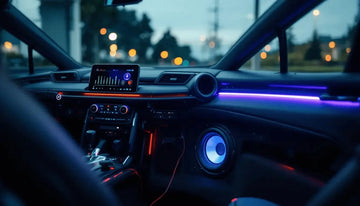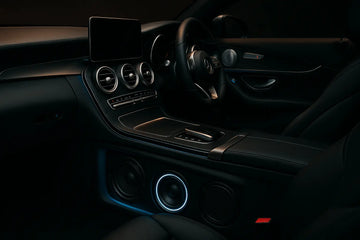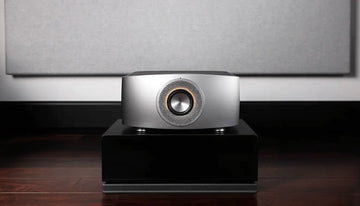Component Sets
Related Collections:
Featured Products
Ground Zero GZIC 13X 5″ 2-way component speaker system
Ground Zero GZIC 16X 6.5″ 2-way component speaker system
Image Dynamics ID65CS Component System
Polk DB5252 5.25" Component Speaker System with Marine Certification
Rainbow Audio EL-C260S 6.5" 2-Way Component Speakers Set
Rainbow Audio SL Pro C260 Component Set
Feelart SQ-6.5G 6.5" 2-Way Car Speaker System | Audio Intensity
AudioCircle Stuttgart Line 6.5" 2-way component speakers
Eton RSE 160 6.5" 2 Way Component Set
MATCH MS 52C 5-1/4" Component Speaker System
Audio Dynamics 2000 Series 5.25″ Component Set – CS524
Unlock Superior Sound: The Ultimate Guide to Component Speakers

Are you tired of the flat, muddy audio from your factory car stereo? Do you turn up the volume only to be met with distortion and crackling? If you're a true music lover, your daily drive deserves a rich, detailed, and immersive soundtrack. This is where component speakers come in. These sophisticated audio systems are the single most impactful upgrade you can make to your vehicle's sound, transforming a mundane commute into a front-row concert experience. Unlike standard all-in-one speakers, a car audio component system uses separate, specialized drivers to reproduce sound with stunning accuracy. The main benefit is achieving unparalleled sound quality and customization, allowing you to build an audio environment perfectly tailored to your ears. Explore our curated selection to find the perfect component speaker set and begin your audio transformation.
What Exactly Are Component Speakers?
At its core, a component speaker system is a set of individual speakers designed to work in perfect harmony, with each part handling a specific range of sound frequencies. Think of it as a professional orchestra versus a one-man band. While a one-man band can be impressive, an orchestra, with its dedicated sections for strings, brass, and percussion, creates a far richer and more detailed tapestry of sound. The same principle applies to your car's audio. A standard factory speaker (known as a coaxial speaker) is the one-man band, trying to do everything at once. A component speaker system is the orchestra.
A typical component speaker set includes three key parts:
-
Woofers: These are the larger drivers, often called a component woofer or mid-woofer, responsible for producing lower and mid-range frequencies. This is where you get the punch of a bass drum, the warmth of a cello, and the core of human vocals. They are usually installed in the factory locations in your car's doors, becoming your new component door speakers.
-
Tweeters: These much smaller drivers are dedicated solely to reproducing high-frequency sounds. Think of the crisp sizzle of cymbals, the delicate notes of a flute, or subtle nuances in a singer's voice. Because they are separate, tweeters can be placed in an optimal listening position, such as on the dashboard or A-pillars, for a more realistic sound.
-
Crossovers: This is the secret weapon of a car audio component system. A crossover is an electronic filter that acts like a traffic director for the audio signal. It takes the full-range signal from your amplifier or head unit and intelligently splits it, sending only low and mid-range frequencies to the woofers and only high frequencies to the tweeters. This audio separation is crucial because it prevents distortion and allows each speaker to operate in its most efficient range, resulting in dramatically cleaner and more accurate sound.
Why Upgrade to Component Speakers for Your Car?
Switching to car component speakers is more than a simple upgrade; it’s a fundamental change in how you experience music in your vehicle. The benefits go far beyond just being louder. The main reason enthusiasts choose a component setup is the pursuit of true audio fidelity. By separating the drivers, you unlock a level of performance that all-in-one coaxial speakers simply cannot match.
The most significant advantages of installing car stereo component speakers include:
-
Enhanced Clarity and Detail: With a dedicated woofer and tweeter, each driver can focus on what it does best. You'll start hearing subtle details in your favorite songs that were previously lost in a muddy mix. The separation of instruments becomes distinct, and vocals sound more present and natural. It's the difference between merely hearing a song and truly listening to it.
-
Superior Soundstage and Imaging: This is where component speakers for car audio truly shine. Factory speakers are usually mounted low in the doors, making it sound like the band is playing at your ankles. Because component tweeters are separate, you can mount them higher up and closer to ear level. This elevates the "soundstage," creating the illusion that the music is coming from in front of you, as if you're at a live show. This precise placement, or "imaging," creates a wide, immersive, and three-dimensional listening experience.
-
Reduced Distortion at High Volumes: The external crossover is a game-changer. By ensuring the woofer isn't struggling to reproduce high-pitched sounds and the tweeter isn't damaged by low bass notes, the entire system can play louder and cleaner. You can turn up the volume to enjoy your music without it breaking up into a distorted mess.
-
Unmatched Customization: The ability to place tweeters independently from the woofers gives you ultimate control over your soundstage. You can aim them directly at the listening position to create a sound field optimized just for you, which is impossible with a fixed coaxial speaker. This makes a component speaker system the top choice for serious audio enthusiasts who want to fine-tune their setup.
Exploring Different Types of Component Speaker Systems
Once you decide to upgrade, you'll find a few different configurations on the market. Understanding these differences will help you select the perfect system for your goals and vehicle. The most common distinction is between 2-way and 3-way systems.
-
2-Way Component Speakers: This is the most popular and widely available type of component speaker system. A 2 way component speaker system includes a matched pair of a component woofer and a tweeter, along with an external crossover. They offer a massive improvement in sound quality over factory speakers and are relatively straightforward to install. For most users, a high-quality set of 2 way component speakers provides the ideal balance of performance, cost, and ease of installation.
-
3-Way Component Systems: For the uncompromising audiophile, a 3-way system adds another driver to the mix: a dedicated mid-range speaker. This driver is designed specifically to handle the frequencies between the woofer and the tweeter, an area where much of the detail in vocals and instruments like guitars and pianos resides. The result is even greater accuracy and a smoother, more detailed sound profile. However, 3-way systems are more complex, require more installation space, and often demand sophisticated tuning to sound their best.
Beyond the configuration, the materials used to construct the speakers significantly impact their sound signature. Woofer cones made from materials like polypropylene are durable and offer a well-balanced sound. More advanced cones made of carbon fiber, Kevlar, or aluminum are lighter and stiffer, providing a faster, more precise bass response. Similarly, tweeter materials vary. Silk dome tweeters are known for a warm, smooth, and natural high-end, while metal dome tweeters (like aluminum or titanium) offer a brighter, more detailed, and crisper sound. Finally, always consider power handling. Look at the RMS (continuous) power rating, not the peak, and ensure it's a good match for your amplifier or head unit.
How to Choose the Best Component Speaker Set for Your Needs
With so many component speakers for sale, picking the right one can feel daunting. However, by focusing on a few key factors, you can easily narrow down the options and find the perfect match for your car and listening preferences. Here’s a practical guide to making your decision.
-
Define Your Budget: The component speaker price can range from surprisingly affordable to premium audiophile-grade. First, set a realistic budget. Even entry-level component systems will offer a significant upgrade over stock speakers. As you move up in price, you'll generally get better materials, more sophisticated crossover designs, and higher power handling.
-
Check Vehicle Compatibility: This step is non-negotiable. Before you buy, you must know what size speakers your car uses. The most common sizes are 6.5-inch and 6x9-inch, but many variations exist. Check your owner’s manual or use an online vehicle fitment tool. It's also crucial to check the mounting depth, as a deep speaker might not fit in a shallow door cavity. You may also need speaker adapter brackets to fit aftermarket speakers in a factory location.
-
Consider Power Requirements: To get the most out of your investment, you should power your component audio speakers with an external amplifier. While some sensitive models can run off a factory head unit, they will truly come alive when given clean, ample power. Match the speaker's RMS power rating to an amplifier's output for optimal, distortion-free performance.
-
Trust Your Ears (and Preferences): What kind of music do you listen to? If you love bass-heavy genres like hip-hop or EDM, look for a system with a robust component woofer. If you prefer the detail of acoustic, classical, or jazz, you might want a system with smooth silk dome tweeters. Reading reviews can give you an idea of a speaker's "sound signature"—whether it's warm, bright, or neutral.
-
Plan for Installation: Installing a car stereo component speaker system is more involved than a simple coaxial swap. It requires removing door panels, running new speaker wire, mounting the crossovers securely (often inside the door or under the dash), and possibly cutting a small hole to mount the tweeters. If you're a confident DIY-er, it's a rewarding project. If not, factoring in the cost of professional installation is a wise move to ensure everything is done correctly and sounds its best.
Frequently Asked Questions About Component Audio Speakers
Q: Are component speakers worth the money?
A: Absolutely. If you care about sound quality, a component speaker system is one of the most worthwhile upgrades for your car. The improvement in clarity, detail, and soundstage—the feeling of a live performance in front of you—is dramatic and something you'll appreciate on every drive.
Q: Can I install component speakers myself?
A: Yes, if you have DIY experience and the right tools. The process involves removing interior panels, wiring the crossovers, and mounting the separate woofers and tweeters. If you're not comfortable with car electronics or modifications, professional installation is highly recommended to guarantee optimal performance and avoid damaging your vehicle.
Q: Do I need an amplifier for component speakers?
A: While some high-sensitivity models can be powered by a factory stereo, using an external amplifier is highly recommended. Component speakers are designed to handle more power, and an amplifier provides the clean, consistent energy they need to reach their full potential in volume, dynamic range, and clarity.
Q: What's the difference between component and coaxial speakers?
A: The main difference is separation. Coaxial speakers are an "all-in-one" design with the tweeter mounted in the center of the woofer. Component speakers have a separate woofer, tweeter, and crossover. This separation allows for better materials, superior sound filtering through the crossover, and optimal tweeter placement for a vastly improved soundstage and imaging.
Q: How do I know what size component speakers fit my car?
A: The best methods are to check your vehicle's owner's manual, use an online vehicle configurator tool, or carefully remove a door panel to measure the existing speaker. You need to confirm both the diameter (e.g., 6.5-inch) and the maximum mounting depth to ensure a proper fit.
Elevate Your Drive with Premium Component Speaker Systems
Investing in a high-quality car audio component system is about more than just making your music louder; it's about transforming your vehicle into a personal listening sanctuary. By harnessing the power of separated audio drivers, you unlock a world of sonic detail, clarity, and immersion that factory systems simply cannot deliver. The superior soundstage created by optimally placed tweeters brings your music to life, placing the performance on a virtual stage in front of you, not at your feet. Combined with the clean, powerful sound made possible by dedicated crossovers, the benefits are undeniable for anyone passionate about music.
Your daily commute, weekend drives, and long road trips can all be enhanced by the rich, dynamic sound that only a proper component speaker system can provide. You'll hear your favorite songs in a new light, discovering nuances you never knew existed. Ready to hear what you've been missing? Explore our extensive selection of component speakers for car audio systems from the industry's most trusted brands. Find the perfect component speaker set for your vehicle, budget, and ears. Your ultimate car audio journey starts here.
Component Sets
Frequently Asked Questions
What is a component speaker set?
What sizes are available for component sets?
What are the benefits of using component speakers over coaxial speakers?
Are the component sets compatible with factory audio systems?
Related Articles

Loudspeakers for Cars: Complete Guide to Upgrading Your Vehicle’s Audio System

Best Car Sub and Speakers for Every Budget in 2025

Best Focused Speaker Technology for Superior Sound Precision















